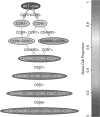RchyOptimyx: cellular hierarchy optimization for flow cytometry
- PMID: 23044634
- PMCID: PMC3726344
- DOI: 10.1002/cyto.a.22209
RchyOptimyx: cellular hierarchy optimization for flow cytometry
Abstract
Analysis of high-dimensional flow cytometry datasets can reveal novel cell populations with poorly understood biology. Following discovery, characterization of these populations in terms of the critical markers involved is an important step, as this can help to both better understand the biology of these populations and aid in designing simpler marker panels to identify them on simpler instruments and with fewer reagents (i.e., in resource poor or highly regulated clinical settings). However, current tools to design panels based on the biological characteristics of the target cell populations work exclusively based on technical parameters (e.g., instrument configurations, spectral overlap, and reagent availability). To address this shortcoming, we developed RchyOptimyx (cellular hieraRCHY OPTIMization), a computational tool that constructs cellular hierarchies by combining automated gating with dynamic programming and graph theory to provide the best gating strategies to identify a target population to a desired level of purity or correlation with a clinical outcome, using the simplest possible marker panels. RchyOptimyx can assess and graphically present the trade-offs between marker choice and population specificity in high-dimensional flow or mass cytometry datasets. We present three proof-of-concept use cases for RchyOptimyx that involve 1) designing a panel of surface markers for identification of rare populations that are primarily characterized using their intracellular signature; 2) simplifying the gating strategy for identification of a target cell population; 3) identification of a non-redundant marker set to identify a target cell population.
Copyright © 2012 International Society for Advancement of Cytometry.
Figures




References
-
- Roederer M, Tárnok A. OMIPsOrchestrating multiplexity in polychromatic science. Cytometry Part A. 2010;77A:811–812. - PubMed
-
- Mahnke YD, Roederer M. OMIP-001: Quality and phenotype of Ag-responsive human T-cells. Cytometry Part A. 2010;77A:819–820. - PubMed
-
- Chattopadhyay P, Roederer M, Price D. OMIP-002: Phenotypic analysis of specific human CD8+ T-cells using peptide-MHC class I multimers for any of four epitopes. Cytometry Part A. 2010;77A:821–822. - PubMed
Publication types
MeSH terms
Substances
Grants and funding
LinkOut - more resources
Full Text Sources

